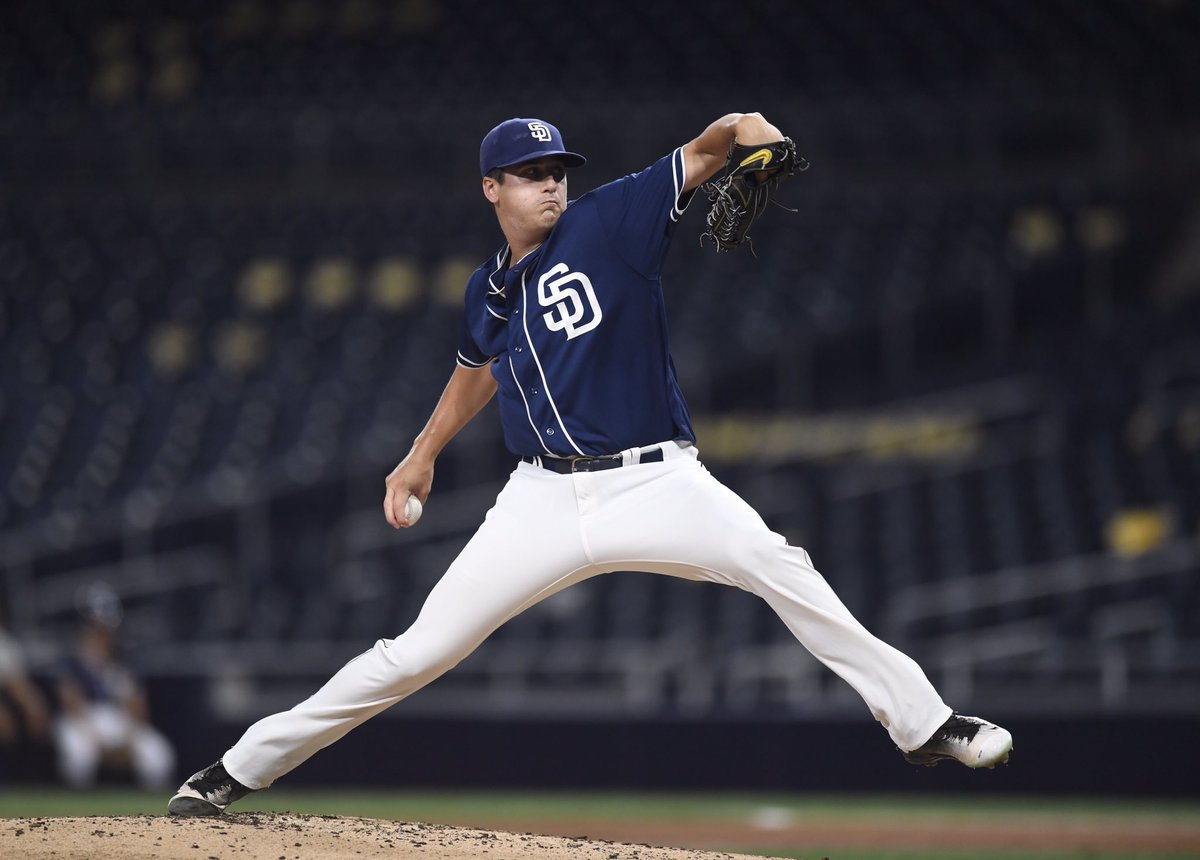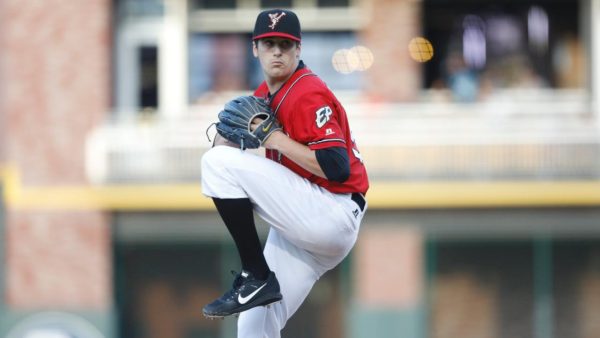The Padres’ Cal Quantrill Can Still Be a Quality Starter

(AP Photo/Charlie Neibergall)

Despite some rough points to the 2018 season, there were positives for the Padres’ prized right-handed pitcher Cal Quantrill. At one point, his year looked like a lost one but he rebounded and performed well after a promotion to Triple-A leaving many excited for his future.
The 2018 minor league season was a poor campaign for Canadian-born pitcher Cal Quantrill.
His first month of the minor league season was a major success as he accumulated a 3.16 earned run average, 1.29 walks plus hits per innings pitched, and a .242 batting average against over five games started. However, in six May starts, his performance quickly deteriorated to the point where his ERA skyrocketed to a discouraging 5.85, his WHIP increased to an unsightly 1.70, and his BAA declined to an unsatisfying .309 rate.
July reinforced the possibility that the young right-hander was a bust. That month was the lowest point in his career as Quantrill struggled immensely. For example, he carried an unbelievable ERA of 8.51. He did not look like the same player San Diego gave up their eighth overall pick in the 2016 draft. Nor did he appear to be the same guy from the year prior who earned the title of 38th best prospect throughout baseball. Instead, the 23-year-old was dashing the hopes of fans who wanted to see a homegrown ace.
Questions about whether the prospect would become useful at all became a legitimate concern.
There are several reasons to stress over Quantrill. One is his fastball. While scouts had once placed a 60 grade on the pitch, reports were less bullish this year. They described how the heater appeared to be more of an average offering at the moment observed. In addition, his slider lost some steam as it also backtracked. However, in this case, a pitch became a liability. His slider used to be average but now it’s below average. The decline in Quantrill’s arsenal explains many of his failures in 2018. They justify his 0.5 point rise in hits per nine, 0.09 increase in batting average against, and one point drop in K rate between 2017 and 2018. The result was a higher ERA.
However, the astronomical rise in earned run average, one full point, is hard to explain based only on pitch effectiveness. The fact that there are only three metrics which trended in the wrong direction supports this claim. Thus, there must have also been some other cause of Quantrill’s fall; otherwise, a full explanation cannot be arrived at. In the process of dissecting this true cause, we learn some positives.
Firstly, the Canadian-born pitcher fell victim to a required system of sequencing. Both the San Antonio and El Paso coach urged the righty to overhaul his pitching order. For example, they asked him to throw more breaking balls and do so early in counts. Their goal was to make Cal’s secondaries more damaging to the opposition and make him more unpredictable. While Quantrill’s slider became, according to scouts, a strikeout pitch, the emphasis made the Stanford product increasingly hittable. As a result, his stock plummeted even though his pitches grew in effectiveness. Also, for most of the season, when Quantrill was at the Double-A level, the hurler was surrounded by sub-par defense. The 23-year-old’s ERA was 5.15 but his FIP statistic was 4.16. In other words, the former first rounder was at the mercy of a damaging defensive corp. If surrounded by more capable fielders, Quantrill may have provided more consistency and greater results.
Besides looking at the causes of Quantrill’s supposed demise, it is also important to discuss whether he exhibited promising signs throughout his 28 starts.

For several reasons, the answer to this question is a resounding yes. By focusing on slider progression, Quantrill developed another possible out pitch. His electric changeup was no longer lonesome in excellence as he found one more tool to arrest hitters. As a result, there is a good chance that his strikeout rate increases substantially next season, especially if further refinement occurs as it should.
Another chunk of fine news is that a new focus on breaking ball advancement did not hinder Quantrill’s superior control. To the contrary, he lowered his BB/9 from 3.1 last year to 2.6 this year. Meanwhile, his overall WHIP of 1.466 didn’t change and his number of groundouts per air outs improved (0.92 to 1.22). Lastly, the prospect showed that he was almost entirely devoid of Tommy John side effects. He threw for 148 innings, 32 more than he had ever pitched before in the professional ranks. The fact that the system did not limit his innings is also a great sign. In short, Quantrill showed that he was more well-rounded this season. He had more weapons to use against the opposition and utilized them well. For instance, he shut down the Springfield Cardinals on June 3 when he struck out ten batters and walked only one during seven innings of work.
The positive changes that Quantrill made in 2018 were on blast in El Paso. Beginning on August 6, the righty demolished Triple-A hitters. After six appearances, he finished with an exceptional 3.48 ERA. While that in itself is stellar, there are some other factors to consider in order to predict what type of pitcher he will likely be for the Padres. His FIP for the Chihuahuas 4.58, higher than the 4.16 he possessed for the Missions. Also, his home runs surrendered rate was elevated .24 points to a mark of 1.16.
These appear to be major caveats to Quantrill’s success at the level; however, he was performing at a ballpark known for its extreme hitter-friendly confines. Thus, his stats there were overblown to a certain extent. Somehow though, he increased his groundball-inducing habit to 1.59, .46 points more than in San Antonio, while also decreasing the number of walks he gave up to a magnificent 1.45 rate per nine innings. In other words, he pitches to weak contact, especially given the fact that he struggled to strike batters out at Triple-A (6.39 K/9).
Overall, his tenure in El Paso is more representative of his skill level and what he can contribute to San Diego. He will probably never be the ace that Preller expected because of his less appealing K rates, but he should be a rotation staple either in the middle or back of the rotation. He is still a valuable member of the Padres’ system and has the potential to be an exciting role player with further adjustments.
I write, I write, and then I write some more.. Lifelong Padres & Chargers fan who is tired of the acceptance of losing that grips all of San Diego sports fans!